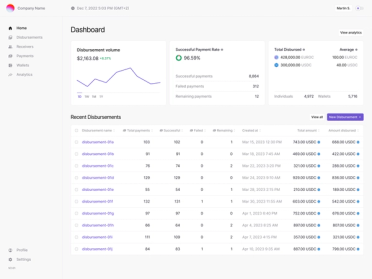Stellar Aid Assist
Bulk humanitarian aid disbursements
Powering the future of aid delivery with a first-of-its-kind blockchain solution delivering instant and transparent digital aid at scale.
Scaling Digital Aid Delivery
Watch it in action
Cash-based interventions serve as a lifeline to millions worldwide in support of basic needs. Stellar Aid Assist leverages the power of the Stellar network and the broader Stellar ecosystem to get money into the hands of those who need it, quickly and at low cost. Easily disburse bulk payments to thousands of recipients in a single batch to ensure organizations can maintain their response readiness in moments of crisis.
A Step-By-Step Process
How it works
01
Leverage digital stablecoins or issue your own assets.
02
Distribute funds to approved recipients.
03
Recipients receive funds instantly in digital wallets.
04
Recipients can cash out funds as needed.
05
Recipients have local currency to spend.
Key Features
A turnkey bulk disbursement platform
Stellar Aid Assist is powered by the Stellar Disbursement Platform, an open-source bulk payment solution available anywhere with an internet connection.
Organizations can review eligibility and then upload recipient information to the Platform and seamlessly initiate a disbursement in seconds.

Who's On Board
Powering global aid delivery

Meet the Partners
Trusted globally
UNHCR launched the first-of-its-kind integrated blockchain payment solution powered by the Stellar network to distribute cash assistance with speed, agility, and accountability in Ukraine.
Case Study
How IRC distributed digital cash assistance
Read how the International Rescue Committee (IRC) sought piloted a blockchain-powered aid disbursement system in Ukraine powered by the Stellar network with Stellar Aid Assist.

Stellar For Everyone
Aid accessible for all
It’s all built on the Stellar network: a proven, decentralized, and open network for moving money anywhere in the world.

Instant
Deliver aid instantly en-masse over Stellar, an efficient and low cost network.

Transparent
Blockchain technology provides traceability of funds to ensure aid goes to those who need it.

Accessible
Recipients just need a mobile phone, no bank account needed.

Global
Tap into an expansive geographic reach with cash-out locations in over 185 countries.

Stable
Leverage stablecoins to offer a stable store of value to recipients.

Low cost
Deliver aid sustainably and at low cost using the Stellar network.
FAQs
An answer to all your questions
- No bank account or prepaid card required
- No transaction or account minimums
- Funds can be held in the recipient’s digital wallet for as long as needed
- Funds can be transported wherever the recipient goes - they do not lose access to their funds by crossing borders
- Removes reliance on physical cash or vouchers- keeping value safer from theft, loss, etc.
- Holding funds in hard currency stablecoins (like digital dollars) protects from local currency devaluation
- Instant bulk disbursement
- End-to-end traceability
- Processing fees around 1 US cent per 10,000 transactions
Blockchain cash disbursements enable organizations to distribute cash assistance directly to individual recipients within minutes at a low-cost. Aid Assist offers real-time bulk disbursements from the Stellar Development Platform (SDP) that can be easily monitored, reducing processing costs and improving operational efficiencies.
Blockchain aid disbursements place cash assistance directly in the hands of individual recipients without requiring a bank account or card solution. Aid Assist enables funds to be disbursed to a digital wallet in a hard currency stablecoin that protects the cash value of funds until a recipient chooses to access cash in local currency either in partial increments or full cash out. Whenever cash is needed, recipients can cash out at access points across the globe, including MoneyGram’s global network of retail locations.
No. Recipients currently do not pay any fees to use the system, access funds, or receive physical cash at MoneyGram. Globally, most aid models are structured in a way that recipients do not incur fees to receive aid. SAA was designed to support this principle. However, the Stellar Development Foundation, which developed SAA, does not have any control over the fees charged by independent organizations participating in SAA flows. In the event an organization wanted to charge fees for facilitating a service like physical cash withdrawals, the organization should work directly with the aid agency to ensure fees are covered by the aid agency.
Organizations can verify eligibility, initiate individual and bulk payments, and disburse funds directly to individual recipients. Finance and program managers can set instructions and review details such as asset type, geography and payment status directly from a user-friendly interface. All transactions are tracked in real-time on the Platform dashboard.
Organizations can choose to host the platform or work with a third-party provider to offer the solution to their treasury and program offices. Learn more about integration in our Developer Docs.
Resources
Learn more
Explore how organizations have implemented Stellar Aid Assist, read more about the benefits of blockchain aid disbursements, and learn more about ongoing cash assistance delivery across the globe. View the resources below to learn more.
Connect with Partnerships
Contact us
Learn more about distributing humanitarian aid on the Stellar network with blockchain disbursements.
Additional Resources
More for you to explore
Resilient with Blockchain
We are pioneering the future of humanitarian aid delivery on the Stellar network. In collaboration with leading international aid organizations, the…
Article
• Dana Bernard
Bulk Disbursements with Beans App and Boss Money
Stellar disbursement platform
Wallets
Beans App and IDT’s Boss Money, two new wallets have joined the Stellar off-ramp ecosystem. Each wallet is now available within the Stellar…
Article
• Dana Bernard
Explore the Open-Source Solution for Bulk Payments: the Stellar Disbursement Platform
Stellar disbursement platform
Open source
Aid
The Stellar Disbursement Platform is a fully open-source solution that provides anyone with the ability to make bulk payments to recipients around…
Article
• Dana Bernard
Blockchain as a Tool for Aid Disbursements
Aid
Aid delivery
Leveraging blockchain technology, aid delivery is underway across the globe backed by the work of humanitarian and refugee organizations.
Article
• Denelle Dixon
Bringing Stellar Aid Assist to a Global Forum
Stellar aid assist
Stellar disbursement platform
December’s launch of Stellar Aid Assist, a new aid disbursement system that is being used in pilot programs by the United Nations High Commissioner…